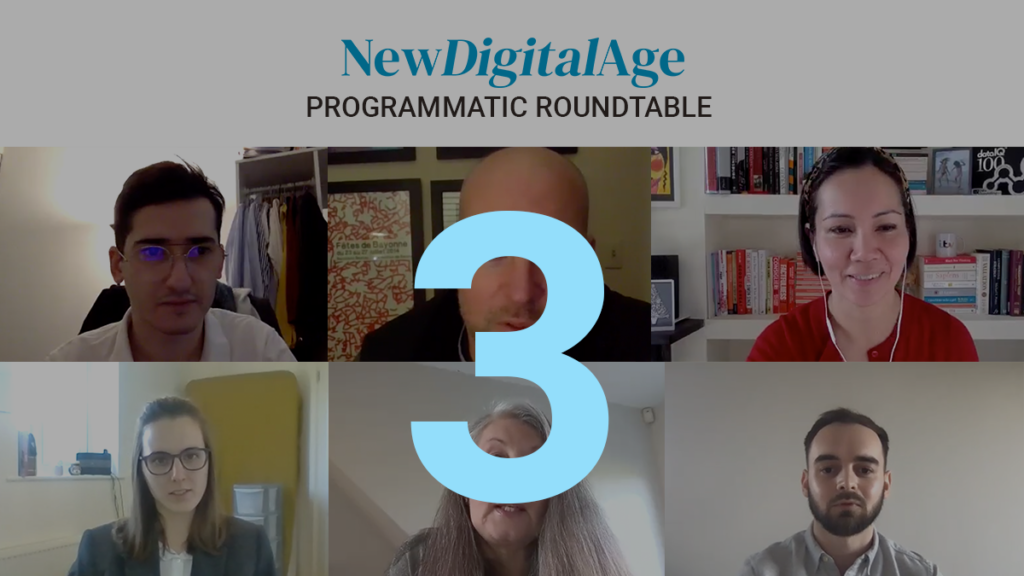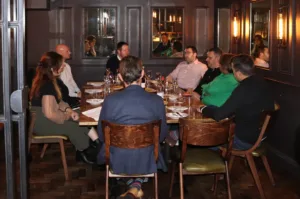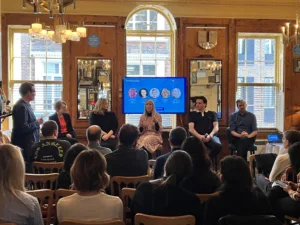Programmatic continues to evolve and – despite many headlines to the contrary – is poised to help transform digital in a post COVID and cookie world.
New Digital Age brought together seven people working in the field for a round-table on the channel’s future programmatic as part of December’s Programmatic Month on the site. All believe that programmatic is on the cusp of a more mature future.
For Tim Cronin, VP of Sales, AAX, it is imperative that programmatic evolves beyond direct response tactics, tools, metrics and measurements. He says: “I know the internet has become the great direct response medium, but the importance for publishers is away from the long tail piece. Especially for these premium publishers we need to find a way to do more branding and sponsorships and focus less on direct response. Premium publishers get really hurt when we start to value their users more so than their content.”
Amelia Carter, Programmatic Specialist, William Hill; Lara Izlan, Director, Advertising Data & Analytics, ITV; Tanya Field, Co-founder and CPO, Novatiq; Raphael Nataf, product owner of Bcovery; Tim Cronin, VP of Sales, AAX; Emma Jensen, Programmatic Director, Digitas UK and Matt Smith, Programmatic Demand Director, VIOOH debated the issues with NDA editor Justin Pearse.
They say that emerging channels, such as connected TV, audio and out of home, present huge opportunities for advertisers, particularly around the brand piece. However, in order to leverage its true value, challenges such as measurement, models and creativity need to be addressed.
Says Field: “Universally everyone’s noted that there’s been massive growth for connected TV, audio and the ability to deliver advertising inside podcasts. That, coupled with the ability to understand the universe of the user, as they migrate through those different environments, is going to be a massive strength for this next year.
“If you know that you can reach the same user in different places and you can have what I call a continued dialogue with the customer, then that’s going to be the huge growth piece.”
Nataf agrees the “absolute winner” for growth in this space is CTV, followed by audio, with opportunities in the gaming apps space. “This is not a surprise for us, knowing that due to the global pandemic the need for interaction and entertainment with the need to bring the sense of the outside world into people’s homes.”
Caution will reap rewards
However, players should beware rushing into these fast-growing spaces without due diligence. Now, say our round-table respondents, is the time to get things right for the months and years ahead.
Izlan believes that there is opportunity to learn from the mistakes of the past and learnings from display in order to rebuild and redefine programmatic for these emerging spaces.
“The thing to note with these new emerging channels is that by their very nature they are powerful creative canvases. They are very different from display though that also has its own strengths,” she says.
“It does suggest that we need to do things differently programmatically for these channels, and that that is not just kind of in how we build the creative but also how we measure campaign success.”
Jensen says it is time to push publishers into looking at more longevity goals such as cost per lifetime user or looking more seriously around brand and ad recall, in tandem with wider research studies such as through Nielsen or Kantar.
“It’s about looking at the bigger picture and what that currency looks like. I don’t think it’s appropriate any more to measure campaign success by volume of clicks or completion rate, though there will always be a purpose for them. From a longevity point of view we need to reevaluate how we measure success for our clients and campaigns.”
It is a common theme with Carter suggesting that “from a brand point of view it is a bit of an unknown territory as to what the future is going to hold for measurement.”
William Hill will still measure relevant metrics such as: impressions, clicks and CTR as well as emerging business-centric metrics. “We need to discuss what is right for us as a brand and with stakeholders, where it aligns to our goals and the added value. Before we start the process to onboard any solution, the time sensitivity around that may be a challenge but I am confident we can overcome this,” she adds.
She is excited by the promise of emerging programmatic channels such as CTV and the creative opportunities around those. “Creativity is a big part of what we do. Think about all the different sports we cover from boxing to football to horse racing, so we have to be dynamic with our creativity because things are constantly changing day to day week to week, month to month.”
The pandemic’s impact
Carter believes that the pandemic, meaning that more people are staying at home and watching screens, coupled with the (delayed) flagship sporting events to be broadcast in 2021, will ensure that CTV is a big opportunity in the year ahead.
Even though DCO has been around for a while, Jensen believes it is only recently that advertisers and agencies are pushing dynamic creative. “Even then, it hasn’t really been a true dynamic creative, it’s been more a poor man’s dynamic creative based on what you’re targeting, then it would then sync up to what would get served not based on true user behaviour,” she adds.
When done well, it works, says Smith, who believes dynamic creative will be huge for his business and the industry in general.
“DOOH doesn’t struggle with a cookie or one-to-one engagement but we do have a challenge with making sure that we can appeal to many audiences as possible, and ensuring messaging is relevant and targeted. That’s where DCO does come into play.”
He cites a campaign VIOOH ran for Renault in Belgium. The car marque wanted to promote its electric model Zoe in Brussels and Liege, but only wanted roadside OOH activity to be live during periods of high pollution. “We took advantage of live air quality data to ensure that activation only happened once the air quality dropped, and then tied the data in with the creative. The trigger-led activation strategy was a massive win for Renault and OMD, as the programmatic OOH element was 26 times more effective versus the direct guaranteed OOH buy, and the campaign overall led to an increase of 144% in searches for the car.” he adds.
Cookies and COVID may have dominated the programmatic conversation over the past months and years, but clarity, creativity and positive innovation will drive its potential in the months and years to come.









